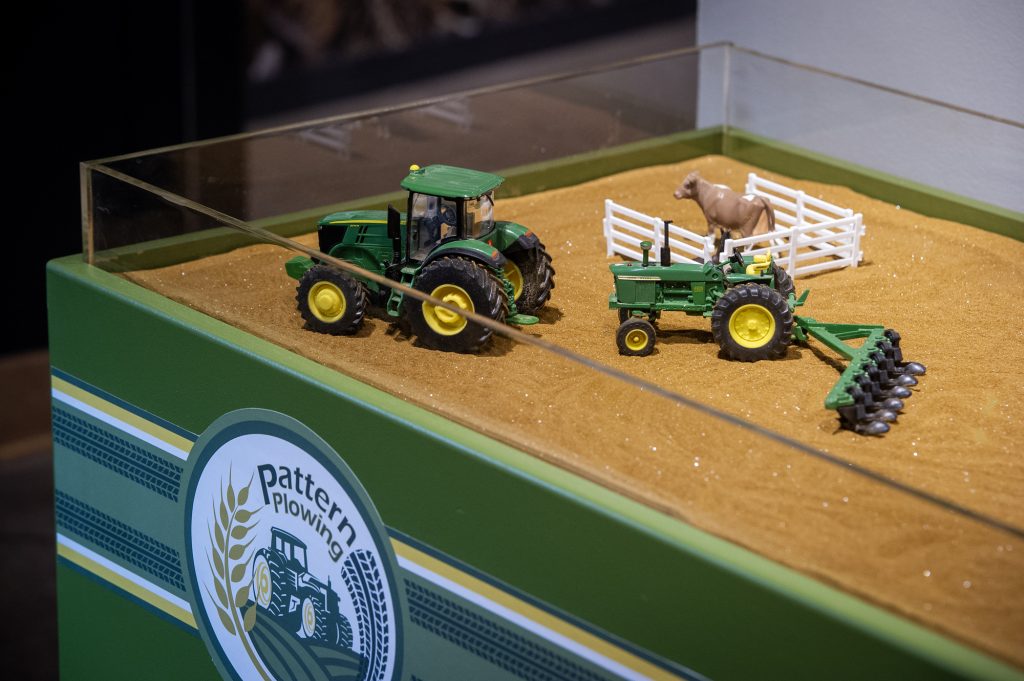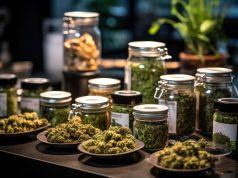
There’s a lot more than food growing on the farms of Boulder County. Just ask the folks at the Longmont Museum and Boulder Museum of Contemporary Art (BMoCA), who paired more than 15 artists with local farmers to explore the relationship between the land, the people who tend it and the communities who rely on it.
Together, the two cultural institutions developed site-specific visual installations on display at five locations in Boulder County, including three farms. Through a range of artistic mediums — ceramics, cyanotypes, digital media, fiber art, photo weavings and more — the joint venture aims to shed light on the connections between agriculture and issues like climate change and water rights.
“All the artists were given the same prompt, but they took it in such different directions and really pulled out different themes,” says Jared Thompson, Longmont Museum curator. “We have art that tells a story about ancestral lands, about food access, about its environmental impact and kind of just all these different stories about what goes into the production of food and farming.”
The ongoing exhibition, agriCULTURE: Art Inspired by the Land, is based on the lived experiences of farmers who collaborated with artists to tell the story of their farms. It invites attendees to use all five senses to explore the work of dozens of artists who linked up with 15 farms to create pieces on display now at BMoCA, Longmont Museum, Ollin Farms, Milk and Honey Farm at the Boulder JCC and the Agricultural Heritage Center.
“We approached [it] almost like dating profiles: We asked the artists and farmers to fill out information about themselves so that we could pair them with someone who would be a good match,” Thompson says. “It was all about getting artists to understand farmers’ concerns, challenges and celebrations, and then translating their stories into a visual format.”
‘Faith in the process’

This multi-venue exhibition invites visitors to explore their own connections to the land and natural world through artistic depictions of farm life. David Dadone, director of BMoCA, first proposed the concept for agriCULTURE more than four years ago. Early on in the process, Dadone approached the Longmont Museum as a potential collaborator and to generate ideas.
After formally deciding to collaborate on the project, the museums asked Boulder Library’s program and events manager, Jaime Kopke, to act as the lead curator and oversee the overall aesthetic coherence. She was ultimately responsible for the individual curation of the three farm sites, in addition to working on pieces with Jane Burke at BMoCA and representatives from the Longmont Museum.
In the artwork on display in the gallery of the Longmont Museum, Thompson aimed to emphasize the extensive, labor-intensive nature of farm life.
“I was interested in featuring a large, immersive piece that mirrors the large-scale nature of agriculture,” he says. “Normally, we do family-friendly exhibitions during this time slot; so, in addition to the six artists’ work that is part of the show, the museum staff created this kids’ section with hands-on farm activities to give younger museum goers something to do.”
Elsewhere visitors will experience eye-catching installations by Nicole Banowetz (Esoterra Culinary Garden), Libby Barbee (The Golden Hoof Farm), Margarita Cabrera (Ollin Farms), Patrick Marold (Bateman Farms), Sarah Sense (The Black Cat), and Sam Van Aken (Boulder Apple Tree Project) throughout the museum.
“This project has been highly experimental for us,” says Joan Harrold, Longmont Museum’s marketing manager. “Until three weeks before the exhibition opened, we had no idea what it was going to look like inside the museum.”
While the six artists had been given space in the gallery and communicated an idea of what they were going to be doing, it was hard to conceptualize without seeing the work installed.
“The pieces are somewhat abstract, so it was tricky trying to imagine what the staging was going to look like until we actually got the stuff here,” Thompson says. “But it’s about having faith in the process, the artists and the farmer. I’m really happy with the way each piece came out. Even though we didn’t give any requirements, they all have a similar color palette and tell a fascinating story about Boulder County’s rich farming heritage.”
‘Why we do this work’
Based on their conversations with farmers throughout the seasons, each piece tells a unique, real-life story. Marold’s work Scale is a massive corn stalk screen that covers the height and width of a wall inside the gallery. He wanted to create something that “would consider broad-scale practices and the potential of working with a farmer that supplies the industry that feeds the majority of the population.”

Through conversations with Keith Batemen, a fifth-generation farmer, Marold developed the piece to represent how much energy it takes to bring food to the table.
“These stalks were visual evidence of a process that we are so easily detached from, even when some of us drive past this field every day,” Marold says. “[The piece] grew out of this dialogue, the physical field where they were collected from, and a sense of scale that I wanted to express to the viewer.”
For environmental sculptor Libby Barbee, who was raised in a southern Colorado farming community and now resides in Denver, this project was an opportunity to get back in touch with her roots.
“As I have gotten older and spent more time living in urban areas, I have become more interested in creating work that addresses the gap in knowledge that exists in many urban communities about our food and where it comes from, as well as the cultural divide that has developed between urban and rural communities,” Barbee says. “I think that it is really important that people understand how their food is grown, both from an environmental standpoint as well as from a social and cultural standpoint.”
Paired with The Golden Hoof Farm, she met with the owner, Alice Maritz Starek, and toured the facility multiple times. Throughout the year, she photographed the farmland as well as her own backyard. Barbee then used these images to create a composition of the landscapes as they change throughout the season, which can be viewed through the window of a large-scale grain silo.
“I was initially interested in exploring soil health, and Alice’s whole farming process is geared towards building the soil on their farm,” Barbee says. “I was especially interested in the cyclical process of growth and decomposition on the farm.”

Farmer Eric Skokan, owner of Black Cat Farm, was partnered with weaver Sarah Sense, whose work reflects her Chitimacha and Choctaw ancestry while incorporating images of the farm. He says this project was a fun opportunity to interact with the community.
“Beyond our family, our greatest treasure is to be a part of this wonderful community,” Skokan says. “We see our farm as one of the many threads that hold our community together. We are simply a thread in this greater tapestry … For us, the agriCULTURE exhibit was a meaningful time for reflection on how and why we do this work.”
More than 300 people attended the gallery’s opening reception at the Longmont Museum. “Many of them were people who were involved in the exhibit, from one of the farms or related to an artist,” Harrod says. “It really demonstrated what a massive collaboration agriCULTURE is and how many community members, who may have never been involved in art-making before, contributed to the installation.”
Because there are so many moving parts in this exhibition, Thompson says it is probably the most difficult project he has ever worked on. He says it is also one of the most satisfying.
“This has been challenging, but I am very proud of the outcome and feel like I have made a lot of really great friends in the community,” he says. “It is really great to highlight Boulder County farms and raise public awareness of them. … agriCULTURE brings awareness to what we have going on in Boulder County, and will hopefully get more people thinking about buying locally to support our farmers.”














